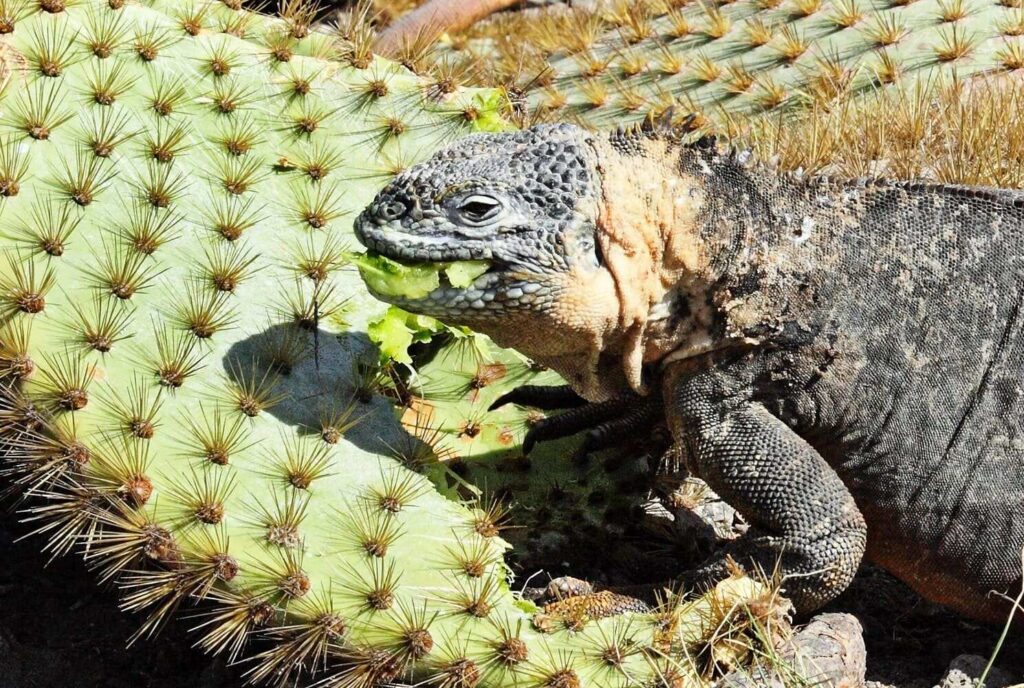What Desert Animals Eat Cactus: a List of Animals That Eat Cactus
What desert animals eat cactus? Both plants and animals have evolved remarkable adaptations to stay alive in the challenging conditions of the desert. To cope with the scarcity of water, a lot of desert organisms have evolved efficient mechanisms for water conservation.

Plants in the desert have also evolved remarkable adaptations for survival. Some desert plants have thick and waxy coatings on their leaves to minimize water loss through evaporation. Others have small or spiky folioles, reducing the surface area exposed to the hot desert air.
What animal eats cactus?
In the dry land ecosystem, several species have modified to eat cactus as part of their diet. A good example is the ground squirrels, that are known to eat cactus plants.

These small desert rodents have sharp teeth and strong jaws that allow them to gnaw through the hard outer layer of prickly pear cactus to access the juicy inner flesh.
Ground squirrels can derive water from the cacti they consume, enabling them to survive in arid environments.
More steppe animals that eat cacti take in some species of desert-dwelling rodents and rabbits. These animals have evolved specialized digestive systems that can break down the fibrous cactus tissue.
They can extract nutrients and moisture from the plants, which helps them survive in harsh desert conditions.
Additionally, certain species of desert tortoises have also been observed eating cactus as a food item in their diet.
It’s important to note that the specific range of animals that eat cacti can vary depending on the species of cacti and the particular desert denizen.
What animals use the cactus in the desert?
Several desert animals count on cactus plants as a food source or a means to obtain water.
A notable example is the Gila woodpecker, a desert bird species that not only can eat cacti seeds but also makes nests in the towering saguaro cactus, protected by the plant’s prickly spines.

These desert birds enjoy eating cacti fruits and insects found among cacti clumps, which makes these plants integral to their diet.
Similarly, desert mammals such as the cactus mouse and the desert pocket mouse are equipped to navigate the sharp spines of the cactus plant.
They are known to eat cacti by gnawing on the cactus pad, a flat, fleshy plant part.
These mice as one of the animals that eat cactus can extract moisture content from the cacti making them crucial for their survival in the arid conditions of the desert.
Other animals, covering several desert-dwelling tortoises and lizards, have demonstrated behaviors of eating cacti plants.
They can handle the prickly pear cactus to access the nutritious and water-filled inner flesh of cacti plants.
Through these adaptations, desert species can turn threats like sharp cacti spines into opportunities, further demonstrating the resilience and adaptive capabilities of life in arid conditions.
It’s important to note that while some animals have adapted to eat cacti and endure their sharp spines, others utilize the plant in different ways.
The cacti, with their sharp spines and water-storing abilities, foster a very specialized and unique ecosystem that allows a host of desert animals to thrive despite the tough environment.
What animal in Arizona eats cactus?
Animals in Arizona consume the prickly pear cacti (Opuntia genus).

These animals have developed specialized adjustments to feed on the cactus without being harmed by its needles. Here is a list of animals that eat the prickly pear cacti in Arizona:
Camels
Camels are known for their capacity to endure dry environments and can eat cacti plants, including the prickly pear cacti. They have strong teeth and a tough palate that allows them to grind and eat cactus pads.

Jackrabbits
Jackrabbits are herbivores and can feed on various vegetation, including cacti. They consume the fleshy parts of the prickly pear cactus plants while avoiding the spikes.

Prairie Dogs
Prairie dogs are members of the Scuiridae (squirrel) family and are related to other ground-dwelling rodents like ground squirrels and chipmunks.

These herbivorous rodents often feed on the flowers and eat cacti fruits, including the prickly pear cacti, as part of their diet. Prairie dogs are known for living in underground colonies, often referred to as “towns.”
Ground squirrels
Certain species of ground squirrels, such as rock squirrels, have been observed consuming cactus plants, including the prickly pear cactus. They can eat cactus fruits, seeds, and pads.

Javelinas
Also known as collared peccaries, javelinas have a diet that includes cactus. They can eat cacti the fruits, pads, and spines of the prickly pear cactus without being affected.

Gila woodpeckers
The Gila woodpecker (Melanerpes uropygialis) is a common and conspicuous woodpecker species found in desert regions.

Gila woodpeckers primarily forage on tree trunks, cacti, outer branches of trees or shrubs, and sometimes on the ground.
It’s important to note that this list is not exhaustive, and there may be other animals in Arizona that also eat the prickly pear cactus.
These animals eat cacti and have specific adaptations that allow them to utilize cacti as one of their food source in the arid desert environment.
What desert animal eats Saguaro cactus?
The Galapagos Land Iguana (Conolophus subcristatus) is a reptile species native to the Galapagos Islands and primarily found in arid desert regions.

While the Galapagos Land Iguanas cacti is known for its herbivorous, it primarily feeds on vegetation such as prickly pear cacti seedlings, and various cacti species found in its habitat.
The Saguaro cactus (Carnegiea gigantea), is the largest cactus in the U.S.
It serves as a remarkable food source for a variety of animals that eat cacti, cacti flesh, or cactus pads, especially during the harsh summer months when water and food are in scarcity.
Cactus plant and desert bird interaction
Major beneficiaries include the Gilded Flicker and Gila woodpecker, known for excavating nest cavities within the flesh of the Saguaro cactus.

Once these birds abandon these cavities, other species, including Elf owls, Screech owls, Purple martins, Finches, and Sparrows, may repurpose them.
The Saguaro cactus also acts as a nesting and hunting platform for larger bird species, such as the Harris’s and Red-tailed hawks, often constructing their nests among the arms of a large Saguaro.
When it comes to pollination, the Saguaro’s flowers provide nectar and pollen for Mexican Long-tongued and Lesser Long-nosed bats.
Notably, the ripening fruit of the Saguaro is an energized food source for small animals like birds, bats, mammals, reptiles, and insects during the summer.
In drier areas of the Sonoran Desert where water sources become limited, Packrats, Jackrabbits, Mule deer, and Bighorn sheep are known to consume the Saguaro’s young flesh to obtain essential moisture.
Although desert animals eat cactus but do not directly eat the mature Saguaro cactus due to its hard outer skin and cactus spines.
They selectively forage it as a source of water, food (nectar, pollen, or fruit), and shelter, leveraging the Saguaro as a critical part of their survival strategy.
Summarize
To conclude we can surely say that there are pretty interesting lists of animals that can not only feed in very specific ways but also may survive in such aggressive conditions and arid environments, feeding on cacti, founding moisture, eating hazardous plants, and impressing the world again and again.
Also Recommended to Read: What Do Cactus Roots Look Like?
FAQ
How many cacti species are eatable?
Cacti, despite their thorny appearance, have been utilized for centuries as a source of food, medicine, and other resources by indigenous cultures.
While not all cacti species are edible, several varieties can be consumed.
The prickly pear cactus (opuntia) is among the most prevalent and extensively used edible cacti.
Animals can eat cacti fruits, flowers, and paddles (nopales) of the prickly pear cactus can be used in various culinary preparations.
However, it’s important to note that the edibility of cacti varies by species, and caution should be exercised when eating cacti, or any other desert shrubs.
How many animals eat cacti?
Several animals include eating desert plants as part of their diet.
A couple of examples include camels, Galapagos land iguanas, jackrabbits, woodrats, Gila woodpeckers, tortoises, squirrels, javelinas, and prairie dogs.
These animals may consume various parts of the cacti, such as the pads, flowers, or fruits, depending on the species.
It is important to note that cacti can be poisonous, and eating them should be approached with caution.
Which mammals enjoy eating cactus?
Many mammals are known to enjoy eating cacti. Some of these mammals include:
Camels. Camels can digest tough fibrous plants, including cacti. They particularly enjoy the prickly pear cactus and jumping cholla.
Camels have thick and leathery lips that help protect them from feeling pain from cactus spines.
Woodrats (or packrats). Woodrats, also known as trade rats, carefully consume cacti, avoiding the spines in the process.
Jackrabbits. Jackrabbits eat cacti near the base, as they consider this part to be juicy. They selectively target areas with fewer or no spines.
Javelinas (or collared peccaries). Javelinas feed on various types of cacti, including the desert prickly pear cactus. They are known to enjoy eating the spines.
Squirrels are active during the day and feed on cactus seeds and fruits while avoiding the spiky parts.
Prairie Dogs. When there is no food they use, prairie dogs may turn to eat cactus. They typically feed on the base, flowers, and fruits of the cactus.
Gila Woodpeckers. While primarily insect eaters, Gila woodpeckers also consume cactus fruits.
They avoid eating the thorns of the cactus and use their pointed beaks to create cavities in the cactus when making their nests.
Which cactus plants are not dangerous for animals and humans?
Christmas Cactus (Schlumbergera spp.). This popular houseplant is non-toxic and safe for pets and humans.
Bunny Ear Cactus (Opuntia microdasys). While it has spines, they are relatively harmless and not considered poisonous.
Hedgehog Cactus (Echinocereus spp.). It is generally safe and non-toxic for animals and humans.
Ladyfinger Cactus (Mammillaria elongata). This small, spiny cactus is generally non-toxic and safe to keep around pets and children.
Zebra Cactus (Haworthiopsis attenuata). This succulent plant, although not a true cactus, is safe for animals and humans.
Please note that while these cactus plants are generally considered safe, individual sensitivities or allergies can vary.

Greetings, dear succulent lovers! I’m Jennifer West and I’m happy to share with you practical tips and guides on growing and caring for succulents, as well as all the magical facts about these unique plants. Grateful to have you on this green journey with me! Check out more about our team here.







